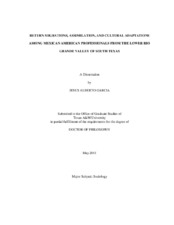| dc.contributor.advisor | Saenz, Rogelio | |
| dc.creator | Garcia, Jesus Alberto | |
| dc.date.accessioned | 2012-07-16T15:56:39Z | |
| dc.date.accessioned | 2012-07-16T20:25:38Z | |
| dc.date.available | 2012-07-16T15:56:39Z | |
| dc.date.available | 2012-07-16T20:25:38Z | |
| dc.date.created | 2011-05 | |
| dc.date.issued | 2012-07-16 | |
| dc.date.submitted | May 2011 | |
| dc.identifier.uri | https://hdl.handle.net/1969.1/ETD-TAMU-2011-05-9161 | |
| dc.description.abstract | Studies of Mexican American integration have come to a methodological and theoretical impasse. Conventional investigations have provided limited insight as they are outsider-based perspectives examining native-born minorities within the context of the immigrant experience and race-cycle paradigms. Grounded in cultural ideologies and nationalist narratives, dominant descriptions of minorities have created a conceptual straight that circumscribes the discourse to assimilationists’ models of integration. Moreover, studies of marginal groups produce negative consequences by highlighting cultural differences that tautologically reinforce the grounds for exclusions. Little grounded work has been conducted specifically looking at racialized native-born minorities and the dynamics of their generational process of integration. Through embedded ethnography and the narratives of subject participants, this research provides direct insight into processes of contemporary integration and the social structural accommodation of native-born Mexican Americans. As a means of sidestepping conceptual barriers, this discussion theoretically frames the integration of Mexican American professionals within the context of modernity and liberal human development.
By responding to the above critiques, this paper presents an alternative approach to the analysis and explanation of the roots of race-cycle paradigms in the first section. The second section establishes the context for the research and explains the basis for the papers structure and conceptual arguments. As a means of moving the discourse away from established models, the third section provides a critical overview of the classical and contemporary literature on minority integration through a process of textual deconstruction. In addition, the section also constructs a theoretical dynamic between structural determinations and individual adaptations to modernity that promotes integration. The fourth section describes the non-traditional method of data collection that provides direct insight into the processes of native-born minority cultural and structural incorporation. Through participant voices, the fifth section describes how individual interactions and institutional forces are shaping the social place that Mexican American professionals have created on the borderlands of American culture and society. What the interpretive findings suggest in the last section is that they are constructing and re-defining their own social and cultural place out of the elements that modern society provides and not as race-cycle theory predicts. | en |
| dc.format.mimetype | application/pdf | |
| dc.language.iso | en_US | |
| dc.subject | Mexican Americans | en |
| dc.subject | Borderland | en |
| dc.subject | Assimilation | en |
| dc.subject | Modernity | en |
| dc.subject | Cultural adaptaions | en |
| dc.title | Return Migrations, Assimilation, and Cultural Adaptations among Mexican American Professionals from the Lower Rio Grande Valley of South Texas | en |
| dc.type | Thesis | en |
| thesis.degree.department | Sociology | en |
| thesis.degree.discipline | Sociology | en |
| thesis.degree.grantor | Texas A&M University | en |
| thesis.degree.name | Doctor of Philosophy | en |
| thesis.degree.level | Doctoral | en |
| dc.contributor.committeeMember | Mestrovic, Stepjan G. | |
| dc.contributor.committeeMember | McIntosh, Alex | |
| dc.contributor.committeeMember | Portales, Marco | |
| dc.type.genre | thesis | en |
| dc.type.material | text | en |


